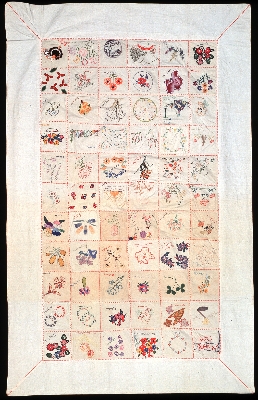Quilt No.938AWM - Australian War Memorial

This quilt is one of 2 signature quilts made by some of the 400 civilian internees in Changi Prison during the first 6 months of their captivity, from March 1942. They were made for the Australian Red Cross and the Japanese equivalent and are at the Australian War Memorial. A third quilt is held by the British Red Cross. It was hoped that the Japanese Red Cross quilt might sway their captors to send the first quilt to Australia. However the authorities returned both quilts to Colonel Collins the senior medical officer, who gave them to Colonel R.M.Webster the medical officer in charge of the Australians at the hospital at Kranji, with the request that one should go to the Australian Red Cross and the other to Colonel Webster's wife. Both were donated to the Australian War Memorial, the latter in 1968 by Mrs. Webster.
The quilts were the idea of a Canadian internee, Mrs. Ethel Mulvaney, who had been a Red Cross representative in Singapore. Making the quilts was designed to alleviate boredom, boost morale and pass information to men in other camps. Each woman was asked to put something of herself into her square. "The quilt for the Japanese was more carefully considered and the squares, with the exception of the one made by American missionaries giving a Psalm reference, contain no messages, only scenes (mainly floral) that the makers thought would be acceptable to the Japanese���.
Two squares on this quilt have an Australian connection. Square 33, made by Helen Beck, the wife of an Englishman serving with the Malay Police (the Becks had spent a holiday in Western Australia in 1941; both were interned by the Japanese), and square 66, made by Clarice Hancock, a Eurasian girl with an Australian father."
[Australian War Memorial]
Related Quilts:
1960 x 800mm
1880 x 1753mm
One of a pair but the other quilt is larger.
1800 x 900mm
2160 x 1830mm





